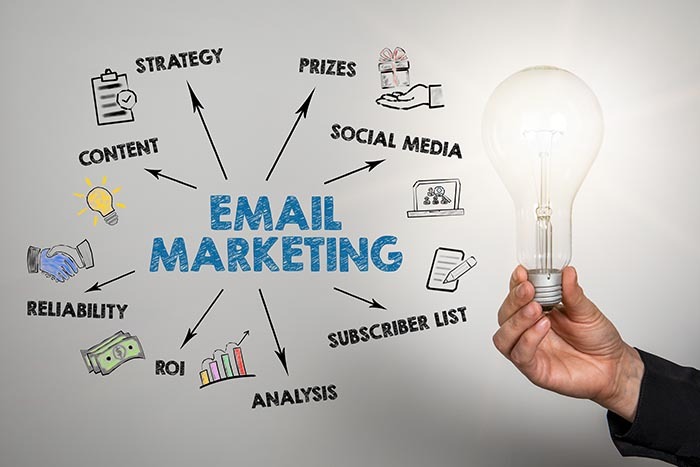
There’s something so satisfying about learning what the “best” marketing tactic is from an article like this one. It’s a definitive statement that you can put in your pocket. When someone else in your organization asks you why you put 70% of your marketing budget somewhere, won’t it be great to have a piece in hand that gives you statistics to back things up?
Please don’t do that with this article. While ROI is a useful measure of success and can help you determine what pieces to put together in your marketing mix, it’s a limited measure and can even create some blind spots. In this article, we’re going to talk about what the top ROI marketing tactic is…and then we’re going to talk about why you need to think of other stuff, too.
The King of Marketing ROI: Email
When it comes to the marketing tactic with the highest ROI, a legion of email marketers online were thrilled to read a 2022 Litmus study that put marketing ROI of email at an average of $36 per dollar spent–so 3,600%. The different data breakouts within that study have been cited for the past two years by pretty much every advertising and marketing blog you can think of. Some will cite the upper range of $45 per dollar spent in the retail, ecommerce, and consumer goods segment, and some will cite that those who a/b test get $42 per dollar spent. Just to compare with other tactics, we’ll cite this WebFx piece that gives an average ROI for a couple of other things that they rank as “top” ROI tactics:
Google Ads: $8 per $1 spent
Pay-Per-Click: $2 per $1 spent
Now let’s return to email marketing: do these statistics mean email will always get you the best results of any tactic? Of course not! And although another WebFx piece on email marketing ROI asserts that email marketing comes out on top because “because of its ability to personalize itself to a user and their wants, questions, and needs,” we’d like to respectfully put forward another hypothesis: It’s cheap, and the results are easy to track!
Reason 1: Low Cost Barrier to Entry
One major reason email is high-ROI on a large scale is due to how cheap it is to get started. At the most basic level, the cost of sending an email is time. And while services like Mailchimp, Hubspot, ActiveCampaign, and others come with costs, they aren’t exorbitant and can drastically cut down on your time spent while maximizing your reach. Besides cold-calling or going up to people and introducing yourself, we can’t really think of a tactic that has a cost beginning at “nearly free” besides email marketing.
Reason 2: Clear Attribution
Another reason why email is king? Easy attribution and crystal-clear causality. In the words of one Reddit user singing the praises of email as the best marketing channel, “[I] sent an email campaign and sold a $900k helicopter.” Another Reddit user on the same thread had a similar story: “I work in mortgage lending so I know first hand one email can produce a $3mil loan.” The sequence of events is so simple there–a single email campaign was sent, then a helicopter was sold. One email was sent, then a $3 million dollar loan was originated.
The same kind of story can’t really be told about SEO or content marketing, which can be more like tectonic shifts that seem slow in the moment but build up to something significant over time. Well-done SEO helps your web traffic go up and helps you reach the right people. Content bolsters your brand and supports SEO. But it’s hard to isolate specific transactions from SEO changes or specific content pieces apart from “conversions” on page, even if you have a way to track broad-strokes marketing metrics. Just judging content pieces by the number of people who responded directly to a lead-gen form on the same page is going to miss a huge amount of value.
Let’s think of a scenario that illustrates this. Your sales team buys some leads, and they’re trying to set appointments over the phone. They set an appointment for tomorrow. Per Saleslion’s research, 77% of b2b purchasers won’t speak to a salesperson without doing their own research online, so you can assume that a visit to the site is in order before the call. The prospect will likely use a search engine to search your name, then they’ll read your site if it’s easy to find—maybe look at some of its content to get to know your company. The outcome of that sales call is going to be attributable to the work of that salesman (and rightfully so) but if you hadn’t laid that groundwork on your website, would the result be the same?
So Should I Do Email Marketing, or Not?
We view email marketing as table-stakes for most b2b and b2c scenarios. Of course you should do email marketing. But weren’t you doing it anyway? (If you weren’t, let us help.) Since you’re already doing it, make sure you’re doing it well. Find a partner who can help you isolate the right tools and approaches to email marketing that work for your unique business, and test, test, test.
Ultimately, a mix of tactics is going to best support your business. Over-focusing on one thing makes you vulnerable to changing business conditions and can leave some potential customers out in the cold. ROI is a helpful metric, but even with the best attribution software you can’t always drill down to specific tactics for a good idea of what’s responsible for short- or long-term wins. An experienced partner like bfw can help you find the mix that works for you now, and fine tune it as times–and your business goals–change. Get in touch to find out how we can help.